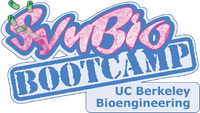Template:SBB10Project-38352
Welcome to your project page!
For each part listed, you should:
- Design oligos to make your part
- Write up proper construction files and put it on the Construction Files page
- Put your oligos on the Oligo Log page
- Put your parts into Clotho
You should design your construction strategy to put your part into plasmid vectorName-Bca1144 (Where vectorName is indicated for each part) using EcoRI and BamHI or just BamHI or BglII for EIPCR. The maps for all plasmids involved in our project can be downloaded here.
Several references have been provided to give you some background on the biology of your part.
Also, use the link above left to upload a picture of yourself, your name, and anything else you'd like.
Finally, you should create a notebook on the main page of the wiki
sbb10: Sleeping beauty (SB100x)
Source: pBca9523-Bca1587
Target Sequence:
GKSKEISQDLRKRIVDLHKSGSSLGAISKRLAVPRSSVQTIVRKYKHHGTTQPSYRSGRRRVLSPRDERTLVRKVQINPRTTAKDLVKMLEETGTKVSISTVKRVLYRHNLKGHSARKKPLLQNRHKKARLRFATAHGDKDRTFWRNVLWSDETKIELFGHNDHRYVWRKKGEACKPKNTIPTVKHGGGSIMLWGCFAAGGTGALHKIDGIMDAVQYVDILKQHLKTSVRKLKLGRKWVFQHDNDPKHTSKVVAKWLKDNKVKVLEWPSQSPDLNPIENLWAELKKRVRARRPTNLTQLHQLCQEEWAKIHPTYCEKLVEGYPKRLTQVKQFKGNATKY*
Vector: pBjk2741
Short description: <SB100x!
Flavor: {<part!}
Family: Transposase
Your part is derived from PMID 19412179. It is a hyperactive mutant of the originally described sleeping beauty transposase.
This part encodes a DNA modifying enzyme
Different DNA modification enzymes are needed in different flavors, so take special note of what type this one should be. DNA modification enzymes are often toxic to E. coli, so you may have some difficulty making this part. Make careful note in your notebook about the size distribution of colonies you get on your plates and the ratio of red to white colonies.
This part is associated with sleeping beauty transposon devices
Sleeping Beauty transposase is a popular enzyme that generates protein-DNA complexes called transposomes from DNAs flanked by "terminal repeats". These terminal repeats, or TR's, are specific cis elements. The transposomes are highly reactive and insert the DNA contained within them randomly into other DNAs (such as a genome).
You should read the following papers
References: DOI 10.1007/s10989-007-9114-z, PMID 19412179
sbb39: Magnesium-repressed Promoter
Source: pBjh1601CK-Bjh1380
Vector: pBjk2741
Short description: {PmgtCB}
Family: Conditional Promoter
This part encodes a Magnesium ion-repressed promoter. In the absence of Mg2+ cations, PmgtCB generates RNA transcripts of downstream DNAs. In the presence of Mg2+, the promoter is shut off by the PhoPQ two-component histidine kinase pathway.
This part exists but requires an EcoRI/BamHI transfer
This part has already been made, but it's with the wrong vector for our assembly program. We need to move the part into a different plasmid. We'll do this with an EcoRI/BamHI transfer. The protocol describing this is here.
sbb40: Nuclear localization peptide
Source: pBjh1601CK-Bjh1858
Vector: pBjk2741
Short description: {<NIS!}
Family: Targeting Peptide
This part encodes a peptide that will target fused proteins to the nucleus of eukaryotic cells.
This part exists but requires an EcoRI/BamHI transfer
This part has already been made, but it's with the wrong vector for our assembly program. We need to move the part into a different plasmid. We'll do this with an EcoRI/BamHI transfer. The protocol describing this is here.
